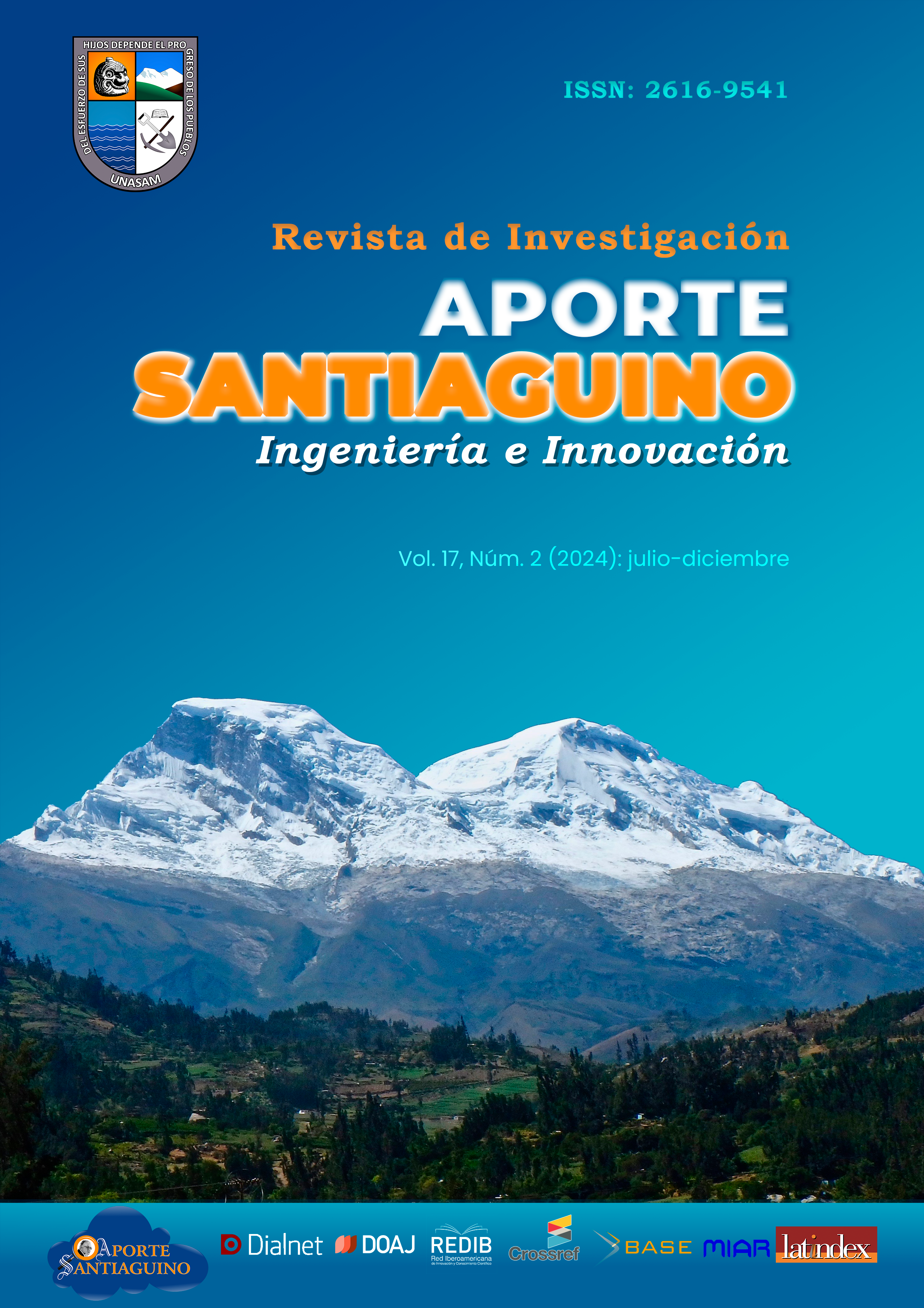Revisión de literatura para el análisis del desempeño del modelo SWAT en la disponibilidad hídrica futura
DOI:
https://doi.org/10.32911/as.2024.v17.n2.1181Palabras clave:
Cambio climático, Disponibilidad hídrica, ;SWAT, Revisión sistemáticaResumen
El cambio climático es un problema global que está afectando la disponibilidad de agua superficial a nivel mundial. Los eventos climáticos extremos van en aumento según predicciones futuras. Esto provoca cambios en los patrones de precipitación, intensificando sequías e inundaciones. El objetivo de la investigación fue realizar una revisión sistemática de artículos indexados desde el año 2014 al 2024, referidos al desempeño del modelo SWAT en la disponibilidad hídrica futura. Los materiales y métodos se basaron en dos etapas bien marcadas: la búsqueda de la literatura y la revisión de la literatura. La primera etapa corresponde a la identificación de la literatura en la base de datos de Scopus, aplicando una cadena de búsqueda en artículos publicados en los últimos 10 años. Luego, se realizó un filtro aplicando 2 criterios de selección. En la segunda etapa se integró la información; se ordenó y se extrajo lo más resaltante para el análisis. La revisión y análisis evidenció un buen desempeño del modelo SWAT en la mayoría de los estudios. En la mayoría existe una tendencia a la disminución de las precipitaciones y la disponibilidad hídrica. En conclusión, el modelo SWAT tuvo un buen desempeño en la mayoría de los estudios revisados. En las proyecciones a futuro, en la mayoría existe una tendencia a la disminución de las precipitaciones y la disponibilidad hídrica.
Descargas
Citas
Abesh, B. F., Jin, L., & Hubbart, J. A. (2022). Predicting Climate Change Impacts on Water Balance Components of a Mountainous Watershed in the Northeastern USA. Water (Switzerland), 14(20). DOI: https://doi.org/10.3390/w14203349
Akhtar, F., Awan, U. K., Borgemeister, C., & Tischbein, B. (2021). Coupling remote sensing and hydrological model for evaluating the impacts of climate change on streamflow in data-scarce environment. Sustainability (Switzerland), 13(24). DOI: https://doi.org/10.3390/su132414025
Alawi, S. A., & Özkul, S. (2023). Impact assessment of climate change on water resources of the Kokcha watershed: a sub-basin of the Amu Darya river basin in Afghanistan. Journal of Water and Climate Change, 14(5). DOI: https://doi.org/10.2166/wcc.2023.504
Al-Falahi, A. H., Saddique, · Naeem, Spank, · Uwe, Pluntke, · Thomas, Gebrechorkos, S. H., Mauder, M., & Bernhofer, · Christian. (2024). Hydrological investigation of climate change impact on water balance components in the agricultural terraced watersheds of Yemeni highland. Theoretical and Applied Climatology. DOI: https://doi.org/10.1007/s00704-024-04913-x
Aloui, S., Mazzoni, A., Elomri, A., Aouissi, J., Boufekane, A., & Zghibi, A. (2023). A review of Soil and Water Assessment Tool (SWAT) studies of Mediterranean catchments: Applications, feasibility, and future directions. In Journal of Environmental Management (Vol. 326). DOI: https://doi.org/10.1016/j.jenvman.2022.116799
Assfaw, M. T., Neka, B. G., & Ayele, E. G. (2023). Modeling the impact of climate change on streamflow responses in the Kessem watershed, Middle Awash sub-basin, Ethiopia. Journal of Water and Climate Change, 14(12), 4837–4859. DOI: https://doi.org/10.2166/wcc.2023.541
Balcha, S. K., Awass, A. A., Hulluka, T. A., Bantider, A., & Ayele, G. T. (2023). Assessment of future climate change impact on water balance components in Central Rift Valley Lakes Basin, Ethiopia. Journal of Water and Climate Change, 14(1). DOI: https://doi.org/10.2166/wcc.2022.249
Blanco-Gómez, P., Jimeno-Sáez, P., Senent-Aparicio, J., & Pérez-Sánchez, J. (2019). Impact of climate change on water balance components and droughts in the Guajoyo River Basin (El Salvador). Water (Switzerland), 11(11). DOI: https://doi.org/10.3390/w11112360
Boru, G. F., Gonfa, Z. B., & Diga, G. M. (2019). Impacts of climate change on stream flow and water availability in Anger sub-basin, Nile Basin of Ethiopia. Sustainable Water Resources Management, 5(4). DOI: https://doi.org/10.1007/s40899-019-00327-0
Budhathoki, A., Babel, M. S., Shrestha, S., Meon, G., & Kamalamma, A. G. (2021). Climate change impact on water balance and hydrological extremes in different physiographic regions of the West Seti River Basin, Nepal. Ecohydrology and Hydrobiology, 21(1). DOI: https://doi.org/10.1016/j.ecohyd.2020.07.001
CEPAL. (2023). Statistical Yearbook for Latin America and The Caribbean 2023. www.issuu.com/publicacionescepal/stacks
Chattopadhyay, S., Edwards, D. R., Yu, Y., & Hamidisepehr, A. (2017). An Assessment of Climate Change Impacts on Future Water Availability and Droughts in the Kentucky River Basin. Environmental Processes, 4(3). DOI: https://doi.org/10.1007/s40710-017-0259-2
Dahal, P., Shrestha, M. L., Panthi, J., & Pradhananga, D. (2020). Modeling the future impacts of climate change on water availability in the Karnali River Basin of Nepal Himalaya. Environmental Research, 185. DOI: https://doi.org/10.1016/j.envres.2020.109430
Deng, Y., Yao, Y., Zhao, Y., Luo, D., Cao, B., Kuang, X., & Zheng, C. (2023). Impact of climate change on the long-term water balance in the Yarlung Zangbo basin. Frontiers in Earth Science, 11. DOI: https://doi.org/10.3389/feart.2023.1107809
Fentaw, F., Hailu, D., Nigussie, A., & Melesse, A. M. (2018). Climate Change Impact on the Hydrology of Tekeze Basin, Ethiopia: Projection of Rainfall-Runoff for Future Water Resources Planning. Water Conservation Science and Engineering, 3(4). DOI: https://doi.org/10.1007/s41101-018-0057-3
Fu, Z., Xie, Y., Zhang, Y., Jiang, X., Guo, H., & Wang, S. (2022). Water Resource Availability Assessment Through Hydrological Simulation Under Climate Change in the Huangshui Watershed of the Qinghai–Tibet Plateau. Frontiers in Earth Science, 9. DOI: https://doi.org/10.3389/feart.2021.755119
Grusson, Y., Wesström, I., Svedberg, E., & Joel, A. (2021). Influence of climate change on water partitioning in agricultural watersheds: Examples from Sweden. Agricultural Water Management, 249. DOI: https://doi.org/10.1016/j.agwat.2021.106766
Haider, H., Zaman, M., Liu, S., Saifullah, M., Usman, M., Chauhdary, J. N., Anjum, M. N., & Waseem, M. (2020). Appraisal of climate change and its impact on water resources of pakistan: A case study of mangla watershed. Atmosphere, 11(10). DOI: https://doi.org/10.3390/atmos11101071
Haleem, K., Khan, A. U., Khan, J., Ghanim, A. A. J., & Al-Areeq, A. M. (2023). Evaluating Future Streamflow Patterns under SSP245 Scenarios: Insights from CMIP6. Sustainability, 15(22), 16117. DOI: https://doi.org/10.3390/su152216117
Huyen, N. T., Tu, L. H., Tram, V. N. Q., Minh, D. N., Liem, N. D., & Loi, N. K. (2017). Assessing the impacts of climate change on water resources in the srepok watershed, central highland of Vietnam. Journal of Water and Climate Change, 8(3). DOI: https://doi.org/10.2166/wcc.2017.135
Ich, I., Sok, T., Kaing, V., Try, S., Chan, R., & Oeurng, C. (2022). Climate change impact on water balance and hydrological extremes in the Lower Mekong Basin: a case study of Prek Thnot River Basin, Cambodia. Journal of Water and Climate Change, 13(8). DOI: https://doi.org/10.2166/wcc.2022.051
IPCC. (2023). Sixth Assessment Report of the Intergovernmental Panel on Climate Change: Tecnical Summary. In Climate Change 2022 – Impacts, Adaptation and Vulnerability. Cambridge University Press. DOI: https://doi.org/10.1017/9781009325844.002
Iranmanesh, R., Jalalkamali, N., & Tayari, O. (2021). Water resources availability under different climate change scenarios in South East Iran. Journal of Water and Climate Change, 12(8). DOI: https://doi.org/10.2166/wcc.2021.373
Karam, S., Zango, B. S., Seidou, O., Perera, D., Nagabhatla, N., & Tshimanga, R. M. (2023). Impacts of Climate Change on Hydrological Regimes in the Congo River Basin. Sustainability (Switzerland), 15(7). DOI: https://doi.org/10.3390/su15076066
Khalilian, S., & Shahvari, N. (2019). A SWAT Evaluation of the Effects of Climate Change on Renewable Water Resources in Salt Lake Sub-Basin, Iran. AgriEngineering, 1(1). DOI: https://doi.org/10.3390/agriengineering1010004
Li, F., Zhang, G., & Xu, Y. J. (2016). Assessing climate change impacts on water resources in the Songhua River Basin. Water (Switzerland), 8(10). DOI: https://doi.org/10.3390/w8100420
Luo, M., Meng, F., Liu, T., Duan, Y., Frankl, A., Kurban, A., & de Maeyer, P. (2017). Multi-model ensemble approaches to assessment of effects of local climate change on water resources of the Hotan River basin in Xinjiang, China. Water (Switzerland), 9(8). DOI: https://doi.org/10.3390/w9080584
Marin, M., Clinciu, I., Tudose, N. C., Ungurean, C., Adorjani, A., Mihalache, A. L., Davidescu, A. A., Davidescu, O., Dinca, L., & Cacovean, H. (2020). Assessing the vulnerability of water resources in the context of climate changes in a small forested watershed using SWAT: A review. DOI: https://doi.org/10.1016/j.envres.2020.109330
Merga, D. D., Adeba, D., Regasa, M. S., & Leta, M. K. (2022). Evaluation of Surface Water Resource Availability under the Impact of Climate Change in the Dhidhessa Sub-Basin, Ethiopia. Atmosphere, 13(8). DOI: https://doi.org/10.3390/atmos13081296
Mishra, Y., Nakamura, T., Babel, M. S., Ninsawat, S., & Ochi, S. (2018). Impact of climate change on water resources of the Bheri River Basin, Nepal. Water (Switzerland), 10(2). DOI: https://doi.org/10.3390/w10020220
Näschen, K., Diekkrüger, B., Leemhuis, C., Seregina, L. S., & van der Linden, R. (2019). Impact of climate change on water resources in the Kilombero Catchment in Tanzania. Water (Switzerland), 11(4). DOI: https://doi.org/10.3390/w11040859
Nath Prajapati, R., Ibrahim, N., & Thapa, R. (2023). Climate change impact on water availability in the Himalaya: Insights from Sunkoshi River basin, Nepal. DOI: https://doi.org/10.1016/j.hydres.2023.10.002
Nedkov, S., Campagne, S., Borisova, B., Krpec, P., Prodanova, H., Kokkoris, I. P., Hristova, D., Le Clec’h G, S., Santos-Martin, F., Burkhard, B., Bekri, E. S., Stoycheva, V., Bruzón, A. G., & Dimopoulos, P. (2022). Modeling water regulation ecosystem services: A review in the context of ecosystem accounting. Ecosystem Services, 56, 101458. DOI: https://doi.org/10.1016/j.ecoser.2022.101458
Nilawar, A. P., & Waikar, M. L. (2019). Impacts of climate change on streamflow and sediment concentration under RCP 4.5 and 8.5: A case study in Purna river basin, India. Science of the Total Environment, 650. DOI: https://doi.org/10.1016/j.scitotenv.2018.09.334
Okwala, T., Shrestha, S., Ghimire, S., Mohanasundaram, S., & Datta, A. (2020). Assessment of climate change impacts on water balance and hydrological extremes in Bang Pakong-Prachin Buri river basin, Thailand. Environmental Research, 186. DOI: https://doi.org/10.1016/j.envres.2020.109544
Ougahi, J. H., Cutler, M. E. J., & Cook, S. J. (2022). Modelling climate change impact on water resources of the Upper Indus Basin. Journal of Water and Climate Change, 13(2). DOI: https://doi.org/10.2166/wcc.2021.233
Pulighe, G., Lupia, F., Chen, H., & Yin, H. (2021). Modeling climate change impacts on water balance of a mediterranean watershed using swat+. Hydrology, 8(4). DOI: https://doi.org/10.3390/hydrology8040157
Quansah, J. E., Naliaka, A. B., Fall, S., Ankumah, R., & Afandi, G. El. (2021). Assessing future impacts of climate change on streamflow within the alabama river basin. Climate, 9(4). DOI: https://doi.org/10.3390/cli9040055
Reshma, C., & Arunkumar, R. (2023). Assessment of impact of climate change on the streamflow of Idamalayar River Basin, Kerala. Journal of Water and Climate Change, 14(7). DOI: https://doi.org/10.2166/wcc.2023.456
Saade, J., Atieh, M., Ghanimeh, S., & Golmohammadi, G. (2021). Modeling impact of climate change on surface water availability using swat model in a semi-arid basin: Case of el kalb river, lebanon. Hydrology, 8(3). DOI: https://doi.org/10.3390/HYDROLOGY8030134
Siddaway, A. P., Wood, A. M., & Hedges, L. V. (2019). How to Do a Systematic Review: A Best Practice Guide for Conducting and Reporting Narrative Reviews, Meta-Analyses, and Meta-Syntheses. In Annual Review of Psychology (Vol. 70). DOI: https://doi.org/10.1146/annurev-psych-010418-102803
Tan, M. L., Gassman, P. W., Liang, J., & Haywood, J. M. (2021). A review of alternative climate products for SWAT modelling: Sources, assessment and future directions. In Science of the Total Environment (Vol. 795). DOI: https://doi.org/10.1016/j.scitotenv.2021.148915
Tan, M. L., Gassman, P. W., Yang, X., & Haywood, J. (2020). A review of SWAT applications, performance and future needs for simulation of hydro-climatic extremes. In Advances in Water Resources (Vol. 143). DOI: https://doi.org/10.1016/j.advwatres.2020.103662
Tan, M. L., Ibrahim, A. L., Yusop, Z., Chua, V. P., & Chan, N. W. (2017). Climate change impacts under CMIP5 RCP scenarios on water resources of the Kelantan River Basin, Malaysia. Atmospheric Research, 189. DOI: https://doi.org/10.1016/j.atmosres.2017.01.008
Touseef, M., Chen, L., & Yang, W. (2021). Assessment of surfacewater availability under climate change using coupled SWAT-WEAP in hongshui river basin, China. ISPRS International Journal of Geo-Information, 10(5). DOI: https://doi.org/10.3390/ijgi10050298
Yin, Z., Feng, Q., Zou, S., & Yang, L. (2016). Assessing variation in water balance components in mountainous Inland River Basin experiencing climate change. Water (Switzerland), 8(10). DOI: https://doi.org/10.3390/w8100472
Yu, Y., Liu, J., Yang, Z., Cao, Y., Chang, J., & Mei, C. (2018). Effect of climate change on water resources in the Yuanshui River Basin: a SWAT model assessment. Arabian Journal of Geosciences, 11(11). DOI: https://doi.org/10.1007/s12517-018-3619-y
Zaman, M., Anjum, M. N., Usman, M., Ahmad, I., Saifullah, M., Yuan, S., & Liu, S. (2018). Enumerating the effects of climate change on water resources using GCM scenarios at the Xin’anjiang Watershed, China. Water (Switzerland), 10(10). DOI: https://doi.org/10.3390/w10101296
Descargas
Publicado
Cómo citar
Número
Sección
Licencia
Derechos de autor 2025 Carlos Martínez Zelaya, Fidel Aparicio Roque

Esta obra está bajo una licencia internacional Creative Commons Atribución 4.0.





















